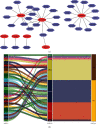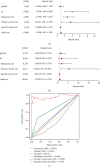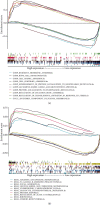A Novel Necroptosis-Related lncRNA Signature for Osteosarcoma
- PMID: 35844445
- PMCID: PMC9283071
- DOI: 10.1155/2022/8003525
A Novel Necroptosis-Related lncRNA Signature for Osteosarcoma
Retraction in
-
Retracted: A Novel Necroptosis-Related lncRNA Signature for Osteosarcoma.Comput Math Methods Med. 2023 Nov 29;2023:9812519. doi: 10.1155/2023/9812519. eCollection 2023. Comput Math Methods Med. 2023. PMID: 38077915 Free PMC article.
Abstract
Backgrounds: Osteosarcoma (OS) is easy to metastasis. Necroptosis-related long noncoding RNA (lncRNA) (NRlncRNA) plays a vital role in the tumorigenesis of many malignant tumors. Nonetheless, there have been few studies investigating the relations between NRlncRNA and OS. During the investigation, NRlncRNAs in OS were confirmed and characterized and their relationships with prognoses were investigated.
Methods: NRlncRNAs were downloaded from The Cancer Genome Atlas (TCGA) OS expression data and clinical-pathological information. First, univariate Cox regression and LASSO regression analyses were used to screen for prognostic-related NRlncRNAs. Second, multivariate regression analyses were used to establish a prognostic nomogram for predicting individual survival probability. Survival analyses demonstrated that high-risk patients (HRPs) had a poor prognosis. In addition, gene set enrichment analyses (GSEA) were used to identify gene function in high- and low-risk groups based on the survival mode.
Results: The 7 NRlncRNAs (AC004812.2, AC022915.1, AC073073.2, AC090559.1, AL512330.1, DDN-AS1, and SENCR) were shown to have a distinct difference and were used to construct an NRlncRNA signature. Using the signature as a risk score was an independent factor for OS patients. The signature divided OS patients into the high- and low-risk groups. Furthermore, the seven lncRNAs were significantly enriched in cell migration and metabolism.
Conclusions: The 7 NRlncRNA survival models have the potential to serve as therapeutic targets and molecular biomarkers for patients with OS, as well as to precisely predict OS prognoses.
Copyright © 2022 Yixin Zheng et al.
Conflict of interest statement
The authors declare that they have no conflicts of interest.
Figures







Similar articles
-
N6-methyladenosine Modification-Related Long Non-Coding RNAs are Potential Biomarkers for Predicting the Prognosis of Patients With Osteosarcoma.Technol Cancer Res Treat. 2022 Jan-Dec;21:15330338221085354. doi: 10.1177/15330338221085354. Technol Cancer Res Treat. 2022. PMID: 35422168 Free PMC article.
-
Predicting prognosis and immune status in sarcomas by identifying necroptosis-related lncRNAs.Aging (Albany NY). 2024 Jan 8;16(1):493-517. doi: 10.18632/aging.205383. Epub 2024 Jan 8. Aging (Albany NY). 2024. PMID: 38194709 Free PMC article.
-
A Novel Necroptosis-Related lncRNA Signature for Predicting Prognosis and Immune Response of Glioma.Biomed Res Int. 2022 Jun 16;2022:3742447. doi: 10.1155/2022/3742447. eCollection 2022. Biomed Res Int. 2022. PMID: 35757472 Free PMC article.
-
Construction of a novel necroptosis-related lncRNA signature for prognosis prediction in esophageal cancer.BMC Gastroenterol. 2022 Jul 15;22(1):345. doi: 10.1186/s12876-022-02421-8. BMC Gastroenterol. 2022. PMID: 35840890 Free PMC article.
-
A novel signature to guide osteosarcoma prognosis and immune microenvironment: Cuproptosis-related lncRNA.Front Immunol. 2022 Jul 29;13:919231. doi: 10.3389/fimmu.2022.919231. eCollection 2022. Front Immunol. 2022. PMID: 35967366 Free PMC article.
Cited by
-
The role of programmed cell death in osteosarcoma: From pathogenesis to therapy.Cancer Med. 2024 May;13(10):e7303. doi: 10.1002/cam4.7303. Cancer Med. 2024. PMID: 38800967 Free PMC article. Review.
-
The role of pyroptosis-related lncRNA risk signature in ovarian cancer prognosis and immune system.Discov Oncol. 2023 Aug 19;14(1):149. doi: 10.1007/s12672-023-00767-3. Discov Oncol. 2023. PMID: 37597098 Free PMC article.
-
A risk model based on ferroptosis- and cuproptosis-related lncRNAs predicts prognosis and immune microenvironment in lung adenocarcinoma by bioinformatics analysis and experimental verification.Am J Cancer Res. 2023 Nov 15;13(11):5306-5319. eCollection 2023. Am J Cancer Res. 2023. PMID: 38058804 Free PMC article.
-
Retracted: A Novel Necroptosis-Related lncRNA Signature for Osteosarcoma.Comput Math Methods Med. 2023 Nov 29;2023:9812519. doi: 10.1155/2023/9812519. eCollection 2023. Comput Math Methods Med. 2023. PMID: 38077915 Free PMC article.
-
The fate and function of non-coding RNAs during necroptosis.Epigenomics. 2024;16(11-12):901-915. doi: 10.1080/17501911.2024.2354653. Epub 2024 Jun 17. Epigenomics. 2024. PMID: 38884366 Free PMC article. Review.
References
-
- Bielack S. S., Kempf-Bielack B., Delling G., et al. Prognostic factors in high-grade osteosarcoma of the extremities or trunk: an analysis of 1, 702 patients treated on neoadjuvant cooperative osteosarcoma study group protocols. Journal of Clinical Oncology: Official Journal of the American Society of Clinical Oncology . 2002;20(3):776–790. doi: 10.1200/JCO.2002.20.3.776. - DOI - PubMed
Publication types
MeSH terms
Substances
LinkOut - more resources
Full Text Sources
Medical

